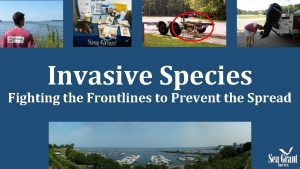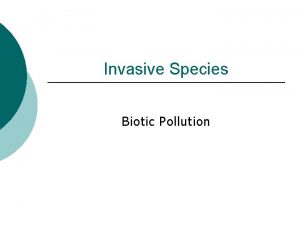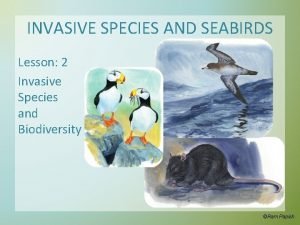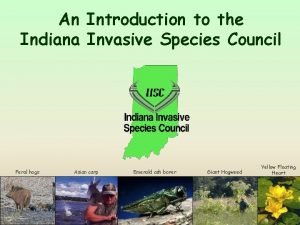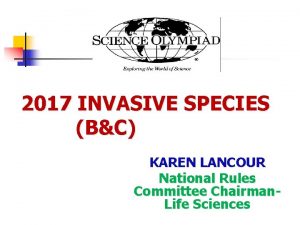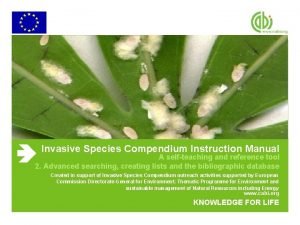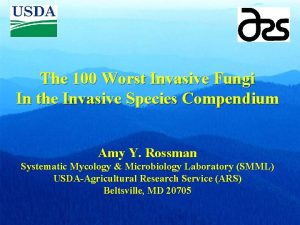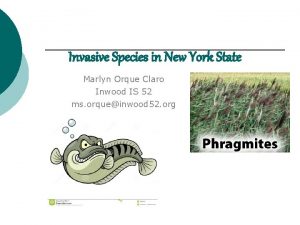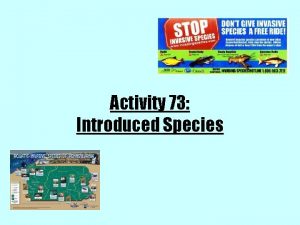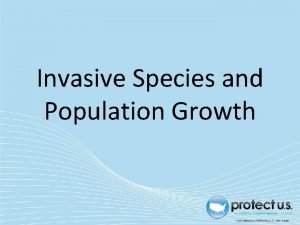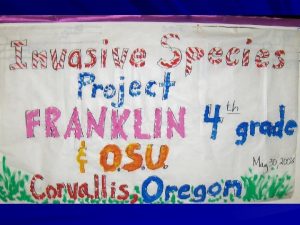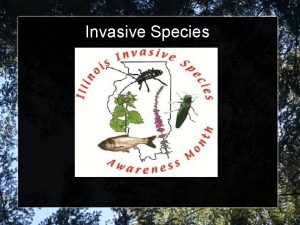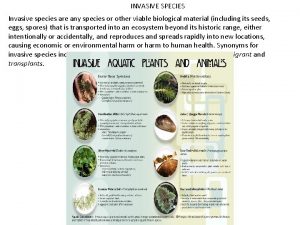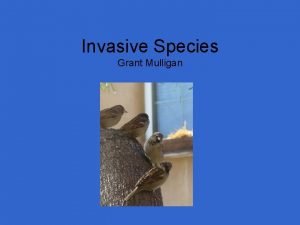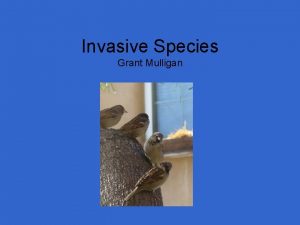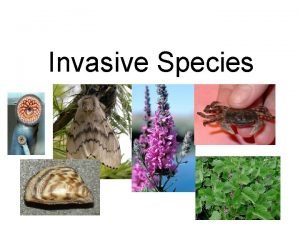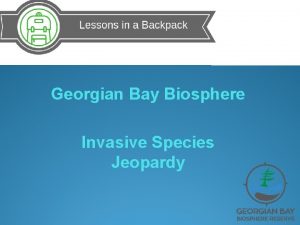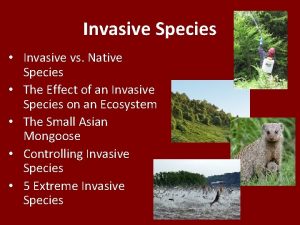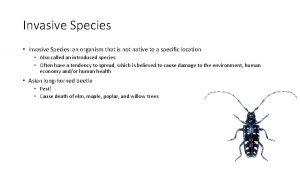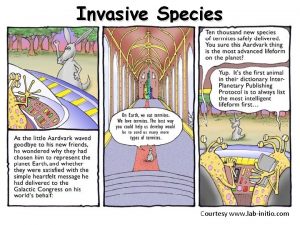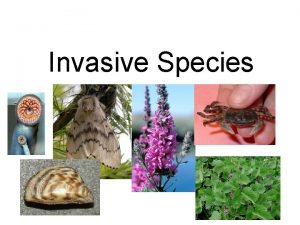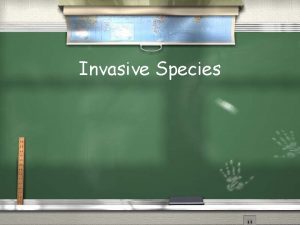Invasive species What do you think an invasive


















- Slides: 18

Invasive species

What do you think an invasive species in? ? ?


What is an Invasive species? § An Invasive species is an organism that is not indigenous/ native to its environment. § Invasive species can be a plant, animal or insect. § Invasive species can be harmful to the enviroment and costly.

Worst Invasive Species § European Rabbit- Has been responible for the extinction of over 8 different mamals § Zebra Mussel- Has been detremental to a variety of species in Great lakes region § Ship Rats- Has caused the extinction of certain birds, plants and small mammals § Feral Pig- has done millions of dollars worth of destruction done to property and farmland

Pros and Cons… § Cons § Can be harmful to environment § Can be costly § Can destroy property § Can be harmful to native species § Pros § Can be used as a form of pest controll

Invasive insects § Can also cause drastic changes habitat § Can endanger animal species. For example certain insects eat other insects that could be food for birds or small rodents § Can spread unique geographical diseases

Asian Tiger Mosquito § Originates in southern and eastern asia § First seen in 1985 in Houston Texas § Known for aggressive biting (frequent) § Do Not transfer HIV/Aids but do give EEE (eastern equine encephalitis). § EEE tend to affect horses the most and has a 80 -90% fatality rate.

Asian Longhorn Beetle § Originally from eastern Asia § First noted in New York 1996 and Chicago 1998 § Infest large trees such as Maples and horse chestnut trees. § Since there is no natural predator scientist say there could be serious ecological problems.

Invasive Animals § Invasive animals are often introduce to an area for the purpose of pest control. § Invasive animals are hard to predict and ultimately become a problem themselves § For example five cats were brought to South Africa for a mouse problem. Five cats turned into 3400 cats and endangered the bird population.

Zebra mussel § Originally from the Black Sea and Caspian Sea in Central Asia § Accidentally brought to America § First seen in Great lakes and have been threatening natural inhabitants because of overpopulation.

Nutria § Originally from South America § Brought to america to be famed for there furs but many were let go because of failing farmers. § They eat the tall grass and many other nutrients important to the wetlands of Chesapeake Bay. This animal has become a major problem to the food web in the Chesapeake bay.

Invasive plants § Usually come From overseas and are usually exotic looking or have unique qualities. Such as Drought intolerance or are extremely fast growing. § They can be dangerous to native plants and search and kill other plants. (example mile-a-minute, purple loosestrife, and kudzu) § They reproduce in high numbers and spread very extensively and well. § 100 million dollars spent to control invasive plants.

Types of invasive plant § § GOOD Wheat Tomatoes Rice § BAD § Lythrum salicaria (purple loosestrife) § Ailanthus altissima (Tree of haven) § Hedera helix (English Ivy)

Tree of Haven (Ailanthus altissima ) § Grows In abandoned alleys § Known for how quickly trees are formed and size of growth § Can cause sidewalk damage or can even emerge from already cracked sidewalks

English Ivy § Cover Most parts of North America § Notoriously known for growing so high that they cover up other plants lower than itself and killing them § Unless maintained they are advised to not be planted

Overview § Invasive species can be costly to us and our property § Can cause disease § Can be harmful to other creatures and there habitats § Sometimes good but overall are never a good thing for anybody http: //youtu. be/e. OEl. BMVz. YNw 0: 00 -2: 05

Citations § § § § Citation Sources Chris. “ 5 worst invasive species”. http: //www. environmentalgraffiti. com/offbeat-news/the-5 -worst-invasive-species-in-the-world/463. November 20, 2011. “Invasive Plants”. The United states National Arboretum. www. usna. usda. gov. December 4. 2009. http: //www. usna. usda. gov/Gardens/invasives. html. November 19, 2011. Princeton University. "Do not harm invasive species that pollinate, study warns. " Science. Daily, 16 Nov. 2011. Web. 27 Nov. 2011. http: //www. sciencedaily. com/releases/2011/11/111116104514. htm. Robert Hilton. “Two Invasive Insect Species from Asia: The Asian Tiger Mosquito and The Asian Longhorn Beetle”. www. proquest. com. December 2000. http: //www. csa. com/discoveryguides/insect/overview. php. November 27, 2011. Tara Ramroop. “Invasive Species”. www. Nationalgeographic. com. Educational. Nationalgeographic. com. http: //education. nationalgeographic. com/education/encyclopedia/invasive-species/? ar_a=4& ar_r=1#page=1. November 17, 2011. United States Environmental protection Agency. EPA. September 29, 2011. November 17. 2011. http: //water. epa. gov/type/oceb/habitat/invasive_species_index. cfm. Citation of Pictures Cheryl Moorehead. “Alainthus Altissima”. Photograph. www. Flickr. com. http: //www. flickr. com/photos/maximillian_millipede/1297310797/sizes/o/in/photostream/. November 27, 2011. Michelle Manii. “Nutria”. Photograph. www. Flickr. com. Iamustique. http: //www. flickr. com/photos/11815777@N 07/5979344635/sizes/o/in/photostream/. November 27, 2011. R. Anson Eaglin. “Asian Long horned Beetle”. Photograph. www. Flickr. com. Usda. gov. July 23, 2009. http: //www. flickr. com/photos/usdagov/4878925300/. November 27, 2011. Smccan. “ Asian tiger misquito”. Photograph. www. Flickr. com. Smccan. http: //www. flickr. com/photos/deadmike/170729124/sizes/z/in/photostream/. November 27, 2011. The Greenmiles. “English Ivy in Arlington”. Photograph. www. Flickr. com. The Greenmiles. http: //www. flickr. com/photos/7856240@N 05/5195068381/sizes/l/in/photostream/. November 27, 2011. The mighty Canadian Jucepig. “Seashells of the Seashore”. Photograph. www. Flickr. com. The mighty Canadian Juicepig. http: //www. flickr. com/photos/juicepig/2150744572/sizes/o/in/photostream/. November 27, 2011.
 Mukesh ambani signature
Mukesh ambani signature Exotic species definition biology
Exotic species definition biology Characteristics of invasive species
Characteristics of invasive species Invasive species characteristics
Invasive species characteristics Invasive species characteristics
Invasive species characteristics Indiana invasive species council
Indiana invasive species council Invasive species characteristics
Invasive species characteristics Invasive species compendium
Invasive species compendium Invasive fungi
Invasive fungi Invasive species investigator worksheet
Invasive species investigator worksheet Invasive species investigator worksheet
Invasive species investigator worksheet Exponential growth of invasive species
Exponential growth of invasive species Are invasive species always bad
Are invasive species always bad Invasive species act ontario
Invasive species act ontario If you think you can you can poem
If you think you can you can poem Keystone plant
Keystone plant Think said the robin think said the jay
Think said the robin think said the jay Think fam think
Think fam think Have a daughter so you can argue
Have a daughter so you can argue


